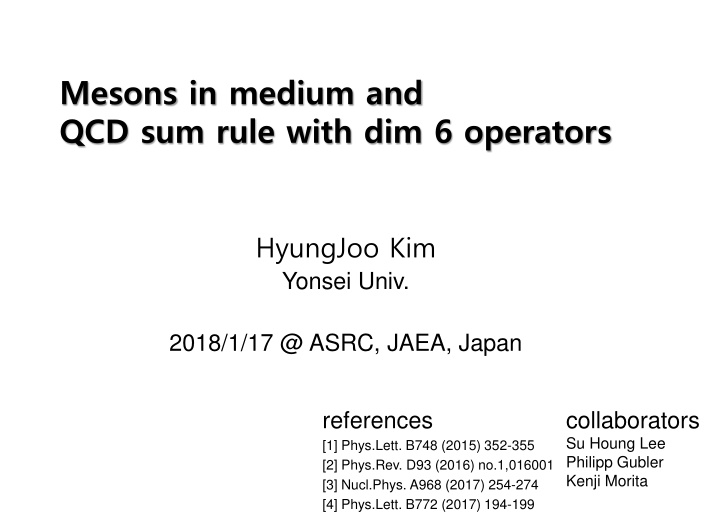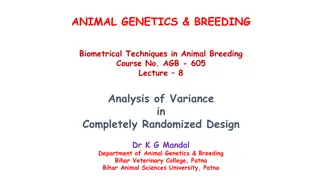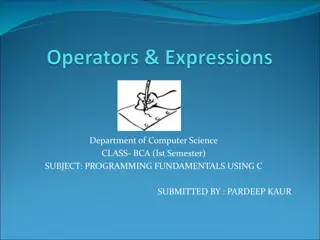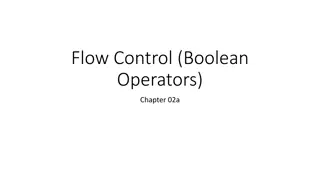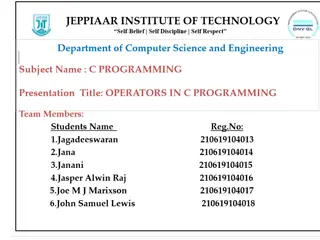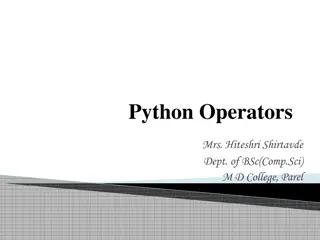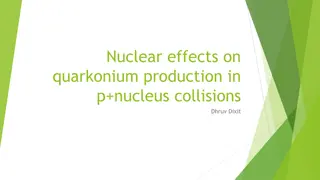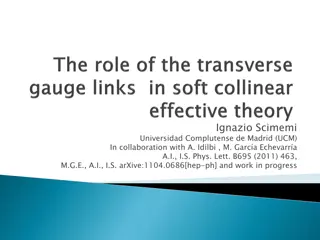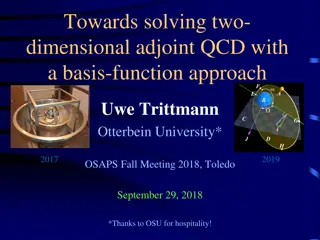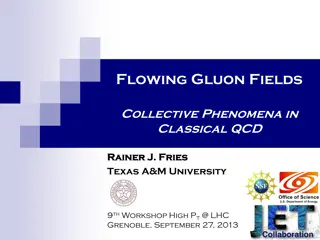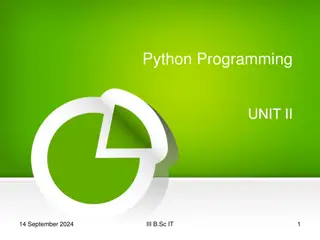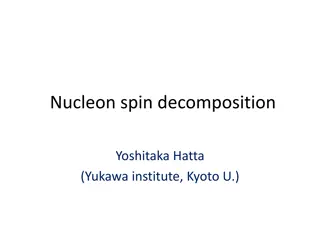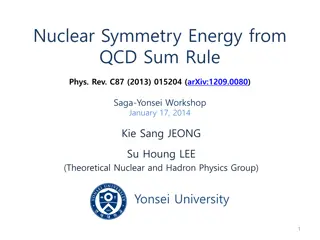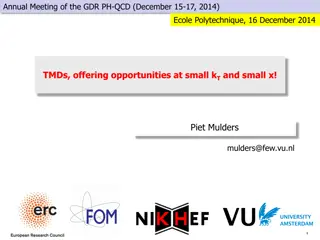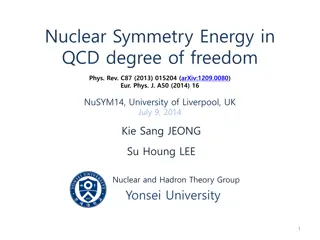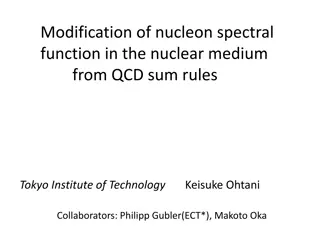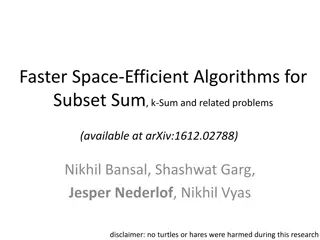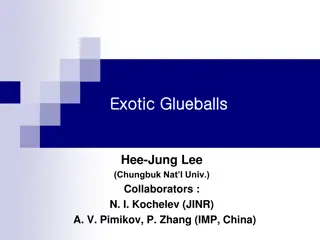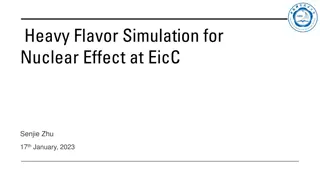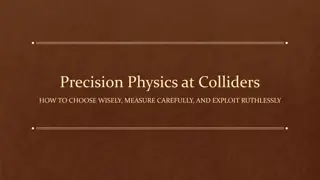Mesons in Medium and QCD Sum Rule with Dim-6 Operators
Study of mesons in medium and their behavior using QCD sum rule with dim-6 operators, exploring mass shifts, broadening, and indicators of quark-gluon plasma. Specifically focuses on charmonium sequential dissociation and non-perturbative methods in QCD such as lattice QCD and Dyson-Schwinger equations.
Uploaded on Sep 21, 2024 | 0 Views
Download Presentation

Please find below an Image/Link to download the presentation.
The content on the website is provided AS IS for your information and personal use only. It may not be sold, licensed, or shared on other websites without obtaining consent from the author.If you encounter any issues during the download, it is possible that the publisher has removed the file from their server.
You are allowed to download the files provided on this website for personal or commercial use, subject to the condition that they are used lawfully. All files are the property of their respective owners.
The content on the website is provided AS IS for your information and personal use only. It may not be sold, licensed, or shared on other websites without obtaining consent from the author.
E N D
Presentation Transcript
Mesons in medium and QCD sum rule with dim 6 operators HyungJoo Kim Yonsei Univ. 2018/1/17 @ ASRC, JAEA, Japan references [1] Phys.Lett. B748 (2015) 352-355 [2] Phys.Rev. D93 (2016) no.1,016001 [3] Nucl.Phys. A968 (2017) 254-274 [4] Phys.Lett. B772 (2017) 194-199 collaborators Su Houng Lee Philipp Gubler Kenji Morita
Out line 1. QCD sum rule for Mesons in medium 2. dim 6 gluon operators 3. Application to Charmonium at finite T 2 / 27
Mesons in medium ?(?) ?(?) At finite T or ? vacuum ? ? ? , ?, Study, Modification of mesons in medium ex) Mass shift, Broadening To understand, - Non trivial structure of QCD vacuum - Phase transition of quark matter ex) Quarkonia indicators of QGP in heavy-ion collision Light mesons probes of partial restoration of chiral symmetry 3 / 27
Mesons in medium - Charmonium Sequential dissociation Charmonium = Sequential dissociation scenario Lattice QCD and potential model expect that the charmonium ground state can survive up to higher T than excited states. -?/? -?? -? real dissociation T ? detailed mechanism ? deconfinement, QGP ex) L=1 L=0 4 / 27
QCD, non-perturbative methods QCD at high E asymptotic freedom pert. QCD at low E confinement, non-pert, hard to describe hadrons directly from ??? hadrons Various approaches to treat Non-perturbativity Lattice QCD NJL ChPT pNRQCD Dyson-Schwinger Ads/QCD correspondence QCD sum rules 5 / 27
QCD sum rule, as a non-perturbative method QCD sum rule by Shifman-Vainshtein-Zakharov in 1979 Hadrons are represented by quark currents. Factorize short distance(asymptotic freedom) and long distance(confinement) using the OPE. Wide applications in hadron phenomenology Determination quark(u,d,s,c,b) masses. Mass, Decay constant, of mesons and baryons successful for charmonium in vacuum. well reproduce masses of the ground sate charmonium electromagnetic decay width of ?/ expect mass difference between ?/ and ??before experiment etc 6 / 27
QCD sum rule, Main Object Correlation function ?{? ? ? 0 } = Amplitude of the quark-pair creation and annihilation ? ? : same quantum number with hadron. ex) scalar meson : ?? , vector meson : ???? ex) ??= ???? ?2= ?? ???? ?{??? ??0 } ? ?, ? pair ?2 ?2 0 Highly virtual photon(?2 0) from hard scattering process Quark-pair propagate at short distance Asymptotic freedom, Almost free quark propagator ?2> 0 Quark-pair propagate at long distance Confinement, Quark-pair confined as vector mesons Observed by dilepton decay ( ?2= ??) ?2> 0 (= ?? 2) 7 / 27
QCD sum rule, OPE part Wilson Coefficient x Local operator Wilson s Operator Product Expansion At short distance ( Q2= q2 1 ), : Condensates Local operators Wilson coefficients = pert. Non-perturbative corrections 8 / 27
QCD sum rule, Phenomenological part By Kallen-Lehman representation, : spectral function at ?2= ? > 0, all hadrons can couple to j(x)| 0 Modeling, 1-pole + continuum Using Dispersion relation ( Q2= q2), s=Re[z] 9 / 27
QCD sum rule, final relation Correlation function From ?2> 0 From ?2 0 Hadronic parameters ??,?? quark mass, ??, Condensates Approximate relation, but useful 10 / 27
QCD sum rule, Borel transformation To pick out the ground resonance state, Borel Transformation ? ? ?? ?2 ? ? : borel distance larger probes longer distance scale 11 / 27
QCD sum rule, Borel transformation ? ?? 2(?) depends on ? ?? limited window = Borel window ??(?) ???? 12 / 27
QCD sum rule, in medium For not extremely high ?,? All medium effects are put into the condensates ???? 0 ???? ?,? Medium breaks Lorentz symmetry Non-scalar operators ???? ? ???? ?, ??? ???? ? ex) ??? ??? 0 ??,?are estimated by various approaches or Lattice QCD. ex) Finite density ??= ?0+ ? ??: linear density approx. Finite temperature ??from Lattice QCD 13 / 27
QCD sum rule, charmonium at finite T w/ dim4 Phys.Rev.D82,054008, 2010. K.Morita, S.H.Lee ?J/ > ? c(without introducing width) But sum rule breaks down slightly above ??. Analysis by K.Morita et al. Peak positions agree well with the experimental values J/ , ??~ 1.1??and c~?? but ground , 1st excited melt almost simultaneously. MEM analysis by P.Gubler et al. arXiv:1703.01438 K.Araki, K.Suzuki, P.Gubler, M.Oka Necessity of dimension 6 gluon operators ? 14 / 27
QCD sum rule, why dim 6 gluon operators? pole becomes weaker, continuum becomes stronger in medium ? ?? ?,? larger ? to see the ground state better. ~1 ?+ ?? Charmonium size becomes large near Tc. larger ? to probe larger distance scale. ~1 ? OPE side, OPE convergence becomes worse, Higher dimensional operators become important. In medium, worthwhile to include dim 6 operators. 15 / 27
Dim 6 gluon operators, independent set dim 6 gluon operators can be made with ??and ???. 2-scalar, 3-twist2, and 1-twist4 are independent. (twist # : twist=symmetric+traceless, #=dimension-spin ) Independent set [??]=1, [???]=2 Renormalization of twist4 16 / 27
Dim 6 gluon operators, Wilson coefficients Wilson coefficients Current structure ??= ???5? ??= ???? ??= ?? ??= ?(????/?2 ???)???5? Wilson coefficients of dim 6 non-scalar gluon operators Cd=6(Q)of for Heavy S, P, and A currents (? = ?,?) for Light S, P, V, and A currents (? = ?,?,?) 17 / 27
Dim 6 gluon operators, Wilson coefficients light lim light= lim heavy heavy? CG CG m 0CG = lim m 0CG m 0CG heavy CQ G heavy C(Q) of heavy quark (c,b) C(Q) of Light quark(u,d,s) ?? ???? ? ??? heavy CQ G 1 ?? ???? = ???? ? + 12? light CG 18 / 27
Dim 6 gluon operators, for heavy quark system Heavy quark system is well described in the pure gauge theory, For charmonium system, only 5 gluon operators up to dimension 6. dim 4 dim 6 19 / 27
Dim 6 gluon operators, T dependece K.Morita, Phys.Rev. D79 (2009) 011501 ??=6 ?=? ?? ??2 ?? ??2 and from Lattice QCD. ? ? dim 4 dim 6 NPA 679 (2001) S.S.Kim, S.H.Lee Phys.Rev. C57 1879 (1998) P.Levai, U.W.Heinz 20 / 27
Dim 6 gluon operators, T dependence Assumption assume fields are isotropic and ignore angular correlations ? ? dim 4 ? ? ? ? dim 6 ? ? ? ? 21 / 27
Application : charmonia at finite T Using, OPE= CI : pert : dim 4 + CG0G0 T+ CG2G2 T + CfG3 fG3 T+ CG3G3 T+ CG4G4 T: dim 6 Wilson coefficients of dim 6 gluon operators. Estimated T dependence of dim 6 gluon condensates. Investigate relative temperature behavior of charmonia near Tc. (sequential dissociation) ????(GeV) 2.98 3.10 3.41 3.51 Particle Current structure JPC ??= ???5? ??= ???? 0 + ?? 1 ?/ ??= ?? 0++ ??0 ??= ?(????/?2 ???)???5? 1++ ??1 22 / 27
[GeV] Result ?? ?/ ??0 ??1 [GeV-2] 23 / 27
Criterion to determine reliable ? window OPE Convergence vs Ground Sate Dominance At low ?, continuum contribution is not suppressed sufficiently. At large ?, higher dimensional operator Truncated OPE is failed ????: ???? : 24 / 27
[GeV] Result [GeV-2] Psuedo Vector Scalar Axial ~1.05 Tc (narrow ?) 1.04 Tc 1.05 Tc 1.04 Tc 25 / 27
Sign of ??? R=-25 R=1 R=+25 at ? = 1.05 ?? = G4x R G4 [GeV] ?0 ?~0.7 ?~0.8 -?4 ?~0.1 ?~0.3 [GeV-2] (-) sign seems to be better for G4. Borel windows shrink faster for S and A. 26 / 27
Summary & Conclusions In medium, dimension 6 operators become important. We identify idep. dim 6 gluon operators. We complete OPE for heavy S, P, V, and A currents up to dim 6. We estimate T dependence of dimension 6 gluon condensate. In our estimation, ?/ looks more stable than ??, but not for ??. In view point of borel window, ?/ , ??are more stable than ??. We need better estimation about T dep of dim 6 condensates. 27 / 27
